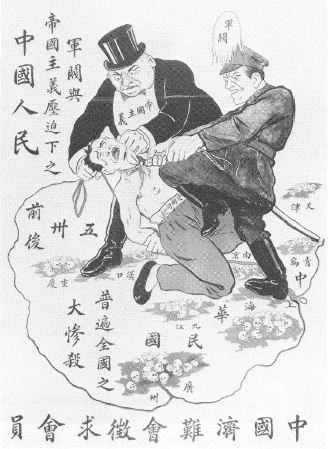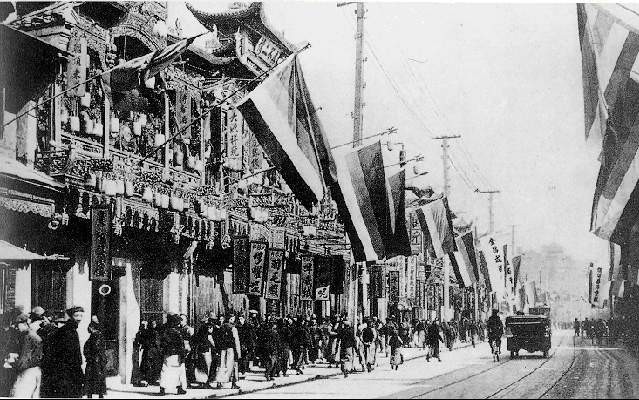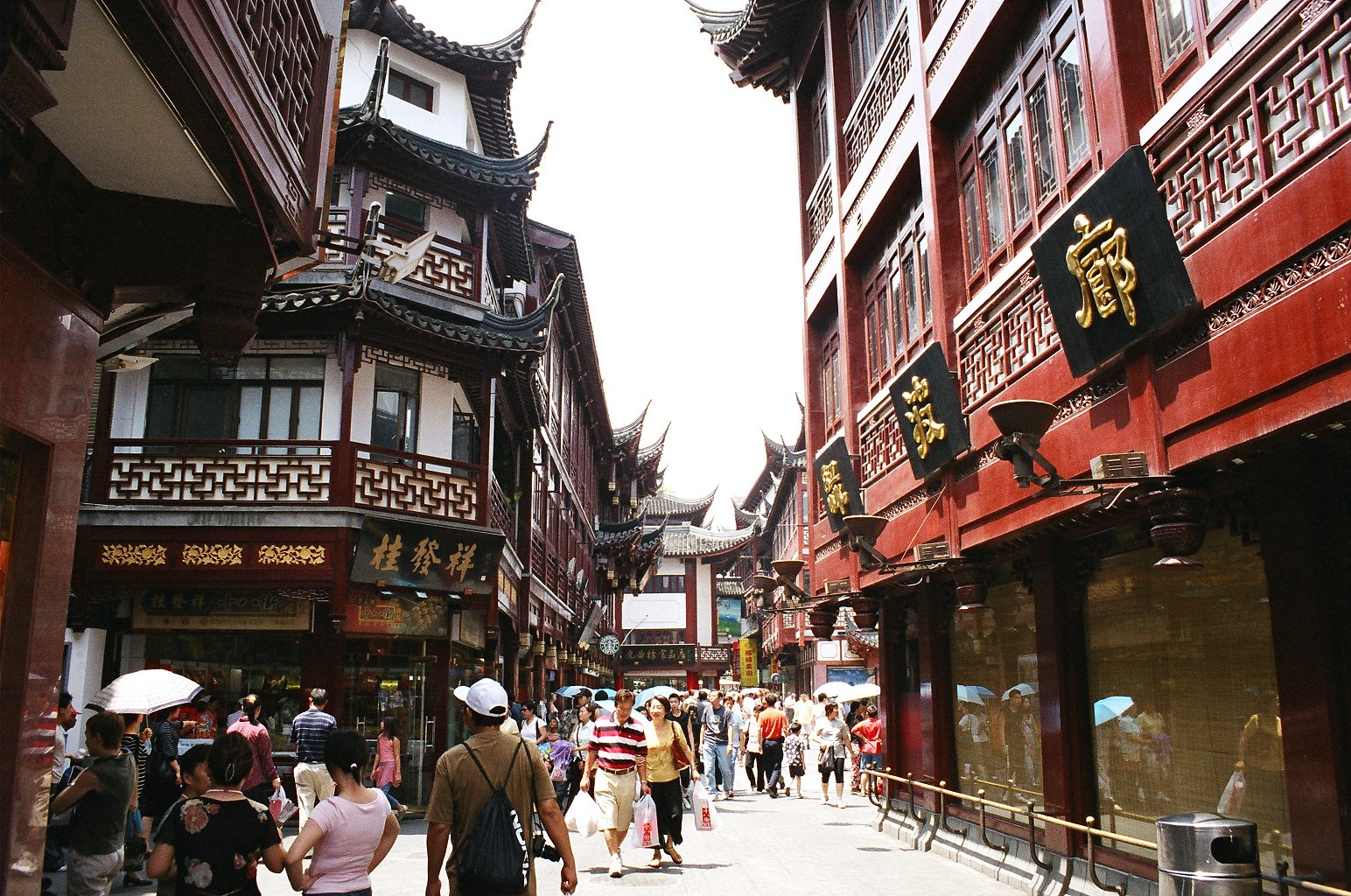|
May Thirtieth Movement Monument
The May Thirtieth Movement Monument is an outdoor sculpture and memorial commemorating to the May Thirtieth movement, installed at People's Park in Shanghai Shanghai (; , , Standard Mandarin pronunciation: ) is one of the four direct-administered municipalities of the People's Republic of China (PRC). The city is located on the southern estuary of the Yangtze River, with the Huangpu River flow ..., China. Description and history The steel sculpture was installed just south of Nanjing Road in the 1990s. It depicts a flame and the two characters for 五 and 卅. Behind the sculpture is a bas relief explaining, in Chinese, the events that took place in 1925. Reception In 2008, Shanghaiist wrote, "we wouldn't recommend it. The city's homeless population apparently fails to grasp the monument's historical richness and instead tend to use its relative seclusion to literally take a piss on their shared heritage. But, in the spirit of the monument, it's kind of fitting the w ... [...More Info...] [...Related Items...] OR: [Wikipedia] [Google] [Baidu] |
Shanghai
Shanghai (; , , Standard Mandarin pronunciation: ) is one of the four direct-administered municipalities of the People's Republic of China (PRC). The city is located on the southern estuary of the Yangtze River, with the Huangpu River flowing through it. With a population of 24.89 million as of 2021, Shanghai is the most populous urban area in China with 39,300,000 inhabitants living in the Shanghai metropolitan area, the second most populous city proper in the world (after Chongqing) and the only city in East Asia with a GDP greater than its corresponding capital. Shanghai ranks second among the administrative divisions of Mainland China in human development index (after Beijing). As of 2018, the Greater Shanghai metropolitan area was estimated to produce a gross metropolitan product (nominal) of nearly 9.1 trillion RMB ($1.33 trillion), exceeding that of Mexico with GDP of $1.22 trillion, the 15th largest in the world. Shanghai is one of the world's major centers for ... [...More Info...] [...Related Items...] OR: [Wikipedia] [Google] [Baidu] |
May Thirtieth Movement
The May Thirtieth Movement () was a major labor and anti-imperialist movement during the middle-period of the Republic of China era. It began when the Shanghai Municipal Police opened fire on Chinese protesters in Shanghai's International Settlement on May 30, 1925 (the Shanghai massacre of 1925). The shootings sparked international censure and nationwide anti-foreign demonstrations and riots. Roots of the Incident In the aftermath of the 1924 Second Zhili–Fengtian War, China found itself in the midst of one of the most destructive periods of turmoil since 1911.Waldron, Arthur, (1991) ''From War to Nationalism: China's Turning Point'', p. 5. The war had involved every major urban area in China, and badly damaged the rural infrastructure. As a result of the conflict the Zhili-controlled government, backed by varied Euro-American business interests, was ousted from power by pro-Japanese warlord Zhang Zuolin, who installed a government led by the generally unpopular statesman Duan ... [...More Info...] [...Related Items...] OR: [Wikipedia] [Google] [Baidu] |
People's Park (Shanghai)
People's Park () is a public park in Huangpu District of central Shanghai. It is located south of Nanjing Road, a major shopping street, and north of People's Square. Originally the northern part of the Shanghai Race Club's race course, the park was created in 1952. With several major museums and Shanghai's main shopping street nearby, it is one of the top tourist destinations in the city. History The park is built on the grounds of the former Shanghai Race Club, which was established by the British in 1862. It was the leading horse racing track in East Asia, and a popular place for the Chinese and the British for gambling on horse racing. The club building, built in 1933, became a landmark in downtown Shanghai. The club's flagpole was considered a great shame for the Chinese, as it was made from the mast of a Chinese warship captured by British and American troops. When the People's Republic of China was founded on 1 October 1949, the new Chinese national flag was hung fro ... [...More Info...] [...Related Items...] OR: [Wikipedia] [Google] [Baidu] |
Shanghai - May Thirtieth Movement Monument - 0016
Shanghai (; , , Standard Mandarin pronunciation: ) is one of the four direct-administered municipalities of the People's Republic of China (PRC). The city is located on the southern estuary of the Yangtze River, with the Huangpu River flowing through it. With a population of 24.89 million as of 2021, Shanghai is the most populous urban area in China with 39,300,000 inhabitants living in the Shanghai metropolitan area, the second most populous city proper in the world (after Chongqing) and the only city in East Asia with a GDP greater than its corresponding capital. Shanghai ranks second among the administrative divisions of Mainland China in human development index (after Beijing). As of 2018, the Greater Shanghai metropolitan area was estimated to produce a gross metropolitan product (nominal) of nearly 9.1 trillion RMB ($1.33 trillion), exceeding that of Mexico with GDP of $1.22 trillion, the 15th largest in the world. Shanghai is one of the world's major centers for fin ... [...More Info...] [...Related Items...] OR: [Wikipedia] [Google] [Baidu] |
Nanjing Road
Nanjing Road (; Shanghainese The Shanghainese language, also known as the Shanghai dialect, or Hu language, is a variety of Wu Chinese spoken in the central districts of the City of Shanghai and its surrounding areas. It is classified as part of the Sino-Tibetan langua ...: ''Noecin Lu'') is a road in Shanghai, the eastern part of which is the main shopping district of Shanghai. It is one of the world's busiest shopping streets, along with Fifth Avenue, Oxford Street, Orchard Road, Takeshita Street and the Champs-Élysées. The street is named after the city of Nanjing, capital of Jiangsu province neighbouring Shanghai, and the former national capital of the Republic of China (1912–1949), Republic of China. Today's Nanjing Road comprises two sections, Nanjing Road East and Nanjing Road West. In some contexts, "Nanjing Road" refers only to what was pre-1945 Nanjing Road, today's Nanjing Road East, which is largely pedestrianised. Before the adoption of the pinyin roman ... [...More Info...] [...Related Items...] OR: [Wikipedia] [Google] [Baidu] |
1990s Establishments In China
Year 199 ( CXCIX) was a common year starting on Monday (link will display the full calendar) of the Julian calendar. At the time, it was sometimes known as year 952 ''Ab urbe condita''. The denomination 199 for this year has been used since the early medieval period, when the Anno Domini calendar era became the prevalent method in Europe for naming years. Events By place Roman Empire * Mesopotamia is partitioned into two Roman provinces divided by the Euphrates, Mesopotamia and Osroene. * Emperor Septimius Severus lays siege to the city-state Hatra in Central-Mesopotamia, but fails to capture the city despite breaching the walls. * Two new legions, I Parthica and III Parthica, are formed as a permanent garrison. China * Battle of Yijing: Chinese warlord Yuan Shao defeats Gongsun Zan. Korea * Geodeung succeeds Suro of Geumgwan Gaya, as king of the Korean kingdom of Gaya (traditional date). By topic Religion * Pope Zephyrinus succeeds Pope Victor I, as the ... [...More Info...] [...Related Items...] OR: [Wikipedia] [Google] [Baidu] |
Huangpu District, Shanghai
Huangpu District (), makes up the eastern part of Shanghai's traditional urban core and is today the most central of Shanghai's 16 districts. Huangpu district is the seat of municipal government, includes key attractions such as The Bund and the Old City God Temple, as well as popular shopping districts such as Nanjing Road, Huaihai Road and Xintiandi. The Huangpu District is one of the most densely populated urban districts in the world. Location The Huangpu District is located in central Shanghai, People's Republic of China on the left bank (i.e., west or north bank) of Huangpu River, after which the district is named. It is opposite to Pudong and is bounded by Suzhou Creek to the north. Today's Huangpu District is sometimes referred to as "new Huangpu" to distinguish it from the pre-merger Huangpu District which existed before 2000. In 2000, the pre-merger Huangpu and Nanshi districts were combined to form a new district, also called Huangpu. In June 2011, the existing Huan ... [...More Info...] [...Related Items...] OR: [Wikipedia] [Google] [Baidu] |
Outdoor Sculptures In Shanghai ''
{{disambiguation ...
Outdoor(s) may refer to: *Wilderness *Natural environment *Outdoor cooking *Outdoor education *Outdoor equipment *Outdoor fitness *Outdoor literature *Outdoor recreation *Outdoor Channel, an American pay television channel focused on the outdoors See also * * * ''Out of Doors'' (Bartók) *Field (other) *Outside (other) *''The Great Outdoors (other) The Great Outdoors may refer to: * The outdoors as a place of outdoor recreation * ''The Great Outdoors'' (film), a 1988 American comedy film * ''The Great Outdoors'' (Australian TV series), an Australian travel magazine show * ''The Great Outd ... [...More Info...] [...Related Items...] OR: [Wikipedia] [Google] [Baidu] |



